Comtek Communications Technology BST75-216 Mini Base Station Transmitter User Manual bst75rear2009
Comtek Communications Technology Inc Mini Base Station Transmitter bst75rear2009
BST 75-216 User's Manual
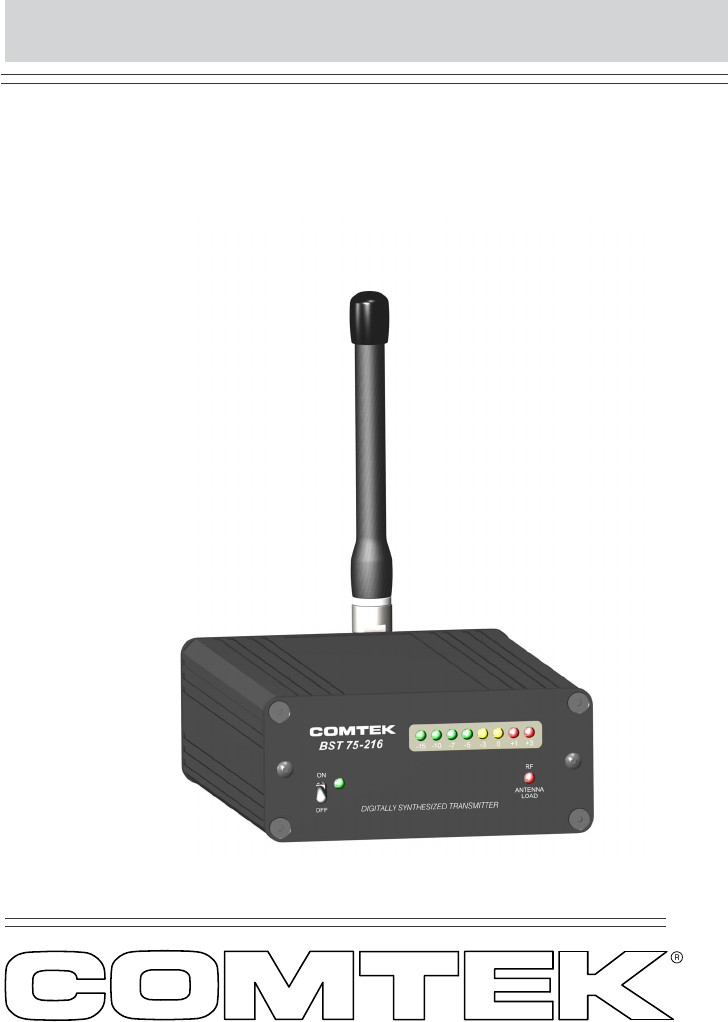
Synthesized
Base Station
Transmitter
BST 75-216 OPERATOR’S MANUAL (216 MHz)
357 West 2700 South • Salt Lake City, Utah 84115 • Phone: (800) 496-3463 • Fax: (801) 484-6906 • www.comtek.com

© 2010 COMTEK® All rights reserved
Printed in U.S.A. 03-10-2010
TABLE OF CONTENTS
Introduction ...........................................................
Equipment Placement ...............................................
Power Requirements .......................................................
Remote Antenna ......................................................
Screw-in Whip Antenna ............................................
Audio Input Connections ...............................................
Audio Adjustments ...............................................
Audio Processing Circuit ..........................................
Front and Rear Panel Facilities ........................................
Frequency Information ..........................................
Accessories ..........................................................
Specifications ......................................................
Warranty and Service ...............................................
1
2
2
3
3
4
4
5
6-7
8-9
10-11
12
13
NOTE: This equipment has been tested and found to comply with the
limits for a Class A digital device, pursuant to part 15 of the FCC Rules.
These limits are designed to provide reasonable protection against
harmful interference when the equipment is operated in a commercial
environment. This equipment generates, uses, and can radiate radio
frequency energy and, if not installed and used in accordance with
the instruction manual, may cause harmful interference to radio
communications. Operation of this equipment in a residential
area is likely to cause harmful interference in which case the user
will be required to correct the interference at his own expense.
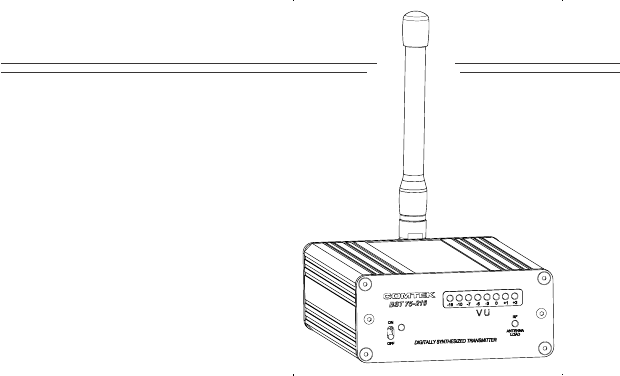
This transmitter may be used for personal listening applications
such as cueing and IFB, wireless automatic tour information
systems, language interpretation, and for assistive listening for
people with hearing loss.
The BST 75-216 mini base station transmitter meets the highest
professional standards while offering outstanding value and the
most advanced technology available. This versatile and innovative
transmitter is simple to use, yet it has sophisticated features such
as “Flash Memory” 57-channel programmability with a synthesized
manual 10-channel selectable user-switch. Plus a unique multi-function
RF indicator detects antenna problems, bad or incorrect antenna, and
open coaxial cable for quick and easy trouble shooting.
The audio processing circuit produces full fidelity frequency
response from 100 Hz to 10 kHz with very low residual FM noise
and distortion. To accommodate a greater variety of receivers, the
BST 75-216 can operate with non-companded receivers or with
companded receivers for higher fidelity sound reproduction with a
signal-to-noise ratio of up to 90 dB.
All this is designed into a stylish, compact, all-metal enclosure suitable
for permanent rack-mount installations or for stand-alone portable
applications.
INTRODUCTION
BST 75-216
Synthesized
Base Station
Transmitter
Page 1
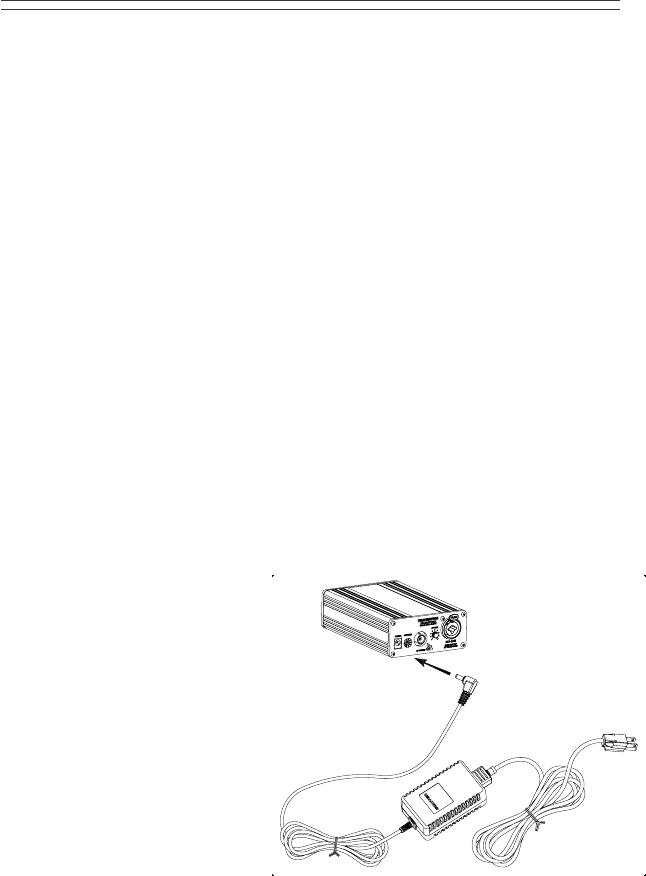
Equipment Placement
If the BST 75-216 base station is to be rack mounted, a remote antenna
must be used. The base station should be mounted away from equipment
that uses large power transformers to reduce 60 Hz hum possibilities.
Special Note: When using the base station in close proximity to other
audio equipment, ensure that the audio equipment is not susceptible to
RF interference. This can be accomplished by temporarily installing
the base station as per above, and then while the base station is
operating, checking all audio outputs for uncharacteristic noise. If a
problem is found, move the base station or the remote antenna as far as
possible from the affected equipment. Should you continue to have
problems, contact COMTEK’s Technical Support Services for
assistance.
Power Requirements
The BST 75-216 base station is designed to be powered by 12 volts DC.
The standard barrel type power jack (5.5mm X 2.1mm) is nonpolar and
will accept either plus or minus 12 volt DC on the
center pin. The switching power
supply adaptor which is included
is a universal input type that will
accept 100-240 volt, 47-63 Hz
(AP-12V1B). The on/off switch
on the front panel of the base
station transmitter should be
turned to the “off” position
when the power plug is
initially plugged into the
transmitter.
Page 2
OPERATING INSTRUCTIONS
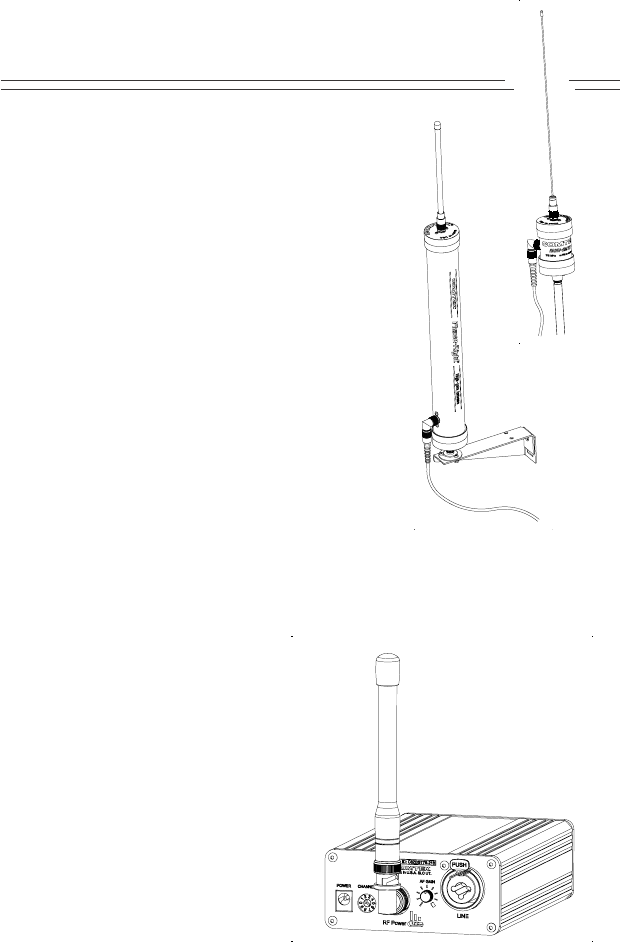
Remote Antenna
When the BST 75-216 base station transmitter
is to be rack mounted for permanent
installation, a remote antenna must be used.
For high performance application when
greater coverage is required, the Phase-Right
or Mini-Mite 1/2 wave omni antenna should
be used. These antennas must be placed
vertically polarized up to 15 feet away from
the transmitter with the coaxial cable
supplied. The highest possible antenna
placement away from any metallic object is
best. For high gain directional yagi type
antennas and specialty antennas, contact
COMTEK’s Technical Support Services.
Short Loaded Whip BNC Antenna
If the BST 75-216 base station transmitter
is to be used outside of the traditional
rack-mounted environment for
stand-alone mobile type applications,
the short loaded whip antenna
(SLW 75-216) should be used.
The transmitter should be placed
on a table or platform as high as
possible so the antenna is at least
24” away from any metallic object.
The radiated output power of
the transmitter with this short
loaded whip antenna will not
be as great as the remote
antennas. The BST 75-216
transmitter should be used only
in the high power setting when
the short loaded whip antenna
is used.
Page 3
OPERATING INSTRUCTIONS
SLW 75-216
Phase-Right
1/2 Wave
Mini-Mite
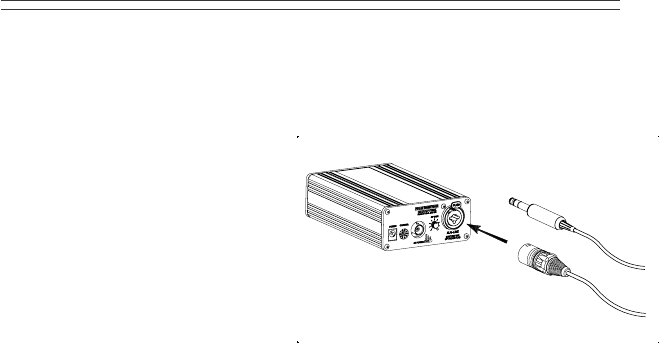
Audio Input Connections
The BST 75-216 base station transmitter uses an XLR-3F connector
with a “Combo” phone jack. The XLR portion of the connector will
accept a true balanced or unbalanced
line level signal up to +20 dBm.
The 1/4” phone jack portion of
the connector may be used for
AUX output level audio or may
directly phantom-power most
two-conductor electret microphones.
Audio Adjustments
In order to ensure the highest possible transmission fidelity, the
transmitter must be modulating at least 50% with normal speech
(0 dB on the VU meter). This adjustment is made in the following
manner:
a. Ensure that the audio source has been optimized for best
signal-to-noise ratio.
b. The XLR-3 connector located on the back of the transmitter is
used for line level balanced or unbalanced audio source (up to +20 dBm).
c. Set the AF Gain Control on the back of the base station to fully
counterclockwise. Then, while normal program information is present,
slowly rotate the “LEVEL” control clockwise until the VU meter on the
front panel begins to deflect. Adjustment should be made so that
normal speech or music deflects the 0 dB yellow LED. Only peak level
of speech or music should deflect the VU meter full-scale into the last
red LED.
Page 4
OPERATING INSTRUCTIONS
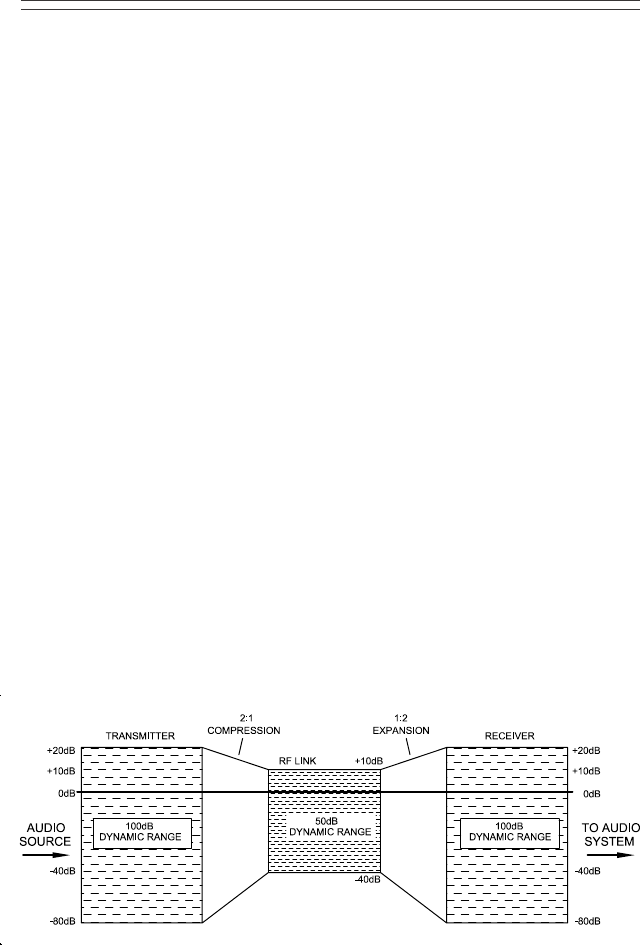
OPERATING INSTRUCTIONS
Audio Processing Circuit
The audio processing system incorporates a peak-level compressor to
prevent over-modulation and reduce audio distortion at high levels.
This compressor has a very fast attack time and a carefully controlled
decay time to optimize the dynamic performance of the audio processing
system. (The VU meter will indicate this compressor action when
the red LEDs are illuminated.) The audio is also equalized to add
pre-emphasis as well as a very sharp high frequency roll-off circuit to
minimize high frequency noise in the audio signal. The total frequency
response and performance of the system is, however, determined by the
corresponding de-emphasis and equalization used in the receiver.
In order to accommodate a greater variety of receivers, the BST 75-216
transmitter incorporates the option to operate with receivers
that have companded or non-companded audio processing.
However, the BST 75-216 transmitter must operate non-companded
with non-companded receivers and companded only with receivers
that incorporate companding processing. A mismatch will result in
unacceptable audio performance.
Basic Companding Theory
The dynamic range of the audio signal is compressed in the transmitter
at a 2:1 ratio. The receiver then expands the audio signal at a
complementary 1:2 ratio to restore the dynamic range of the audio signal
to the original level and also to provide additional noise reduction
when no audio signal is present.
Page 5
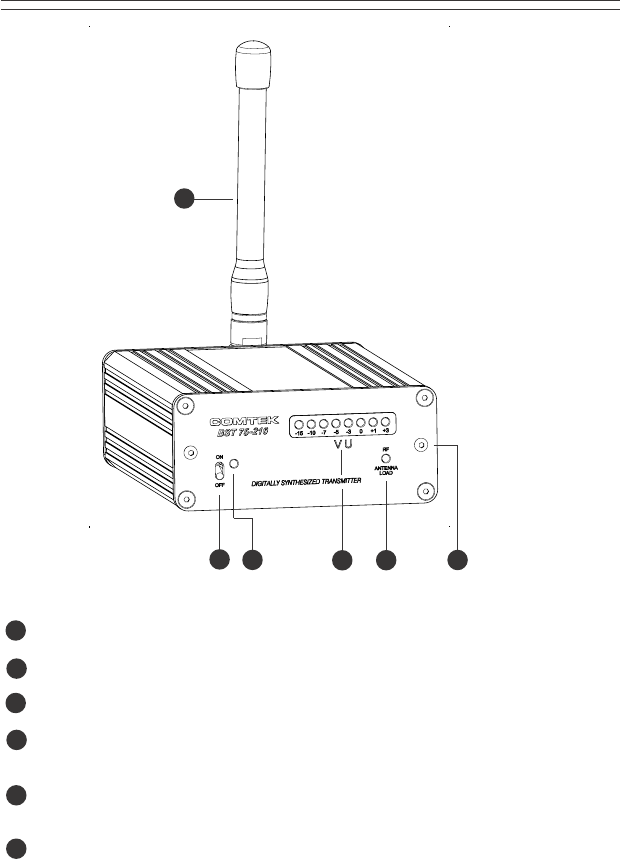
OPTIONAL ANTENNA: Used for mobile type applications.
POWER SWITCH: Turns the transmitter on or off.
POWER LED INDICATOR: Illuminates when the power is on.
VU METER: Displays the audio level being used for modulation.
(See Audio Adjustment Section.)
ANTENNA INDICATOR: Detects antenna problems: bad, or incorrect
antenna, and open coaxial cable.
RACK-MOUNTING SCREWS: Used for mounting BST 75-216 to
rack-mounting panels.
BST 75-216 FRONT PANEL
Page 6
4
3
2
1
3 54
26
5
1
6
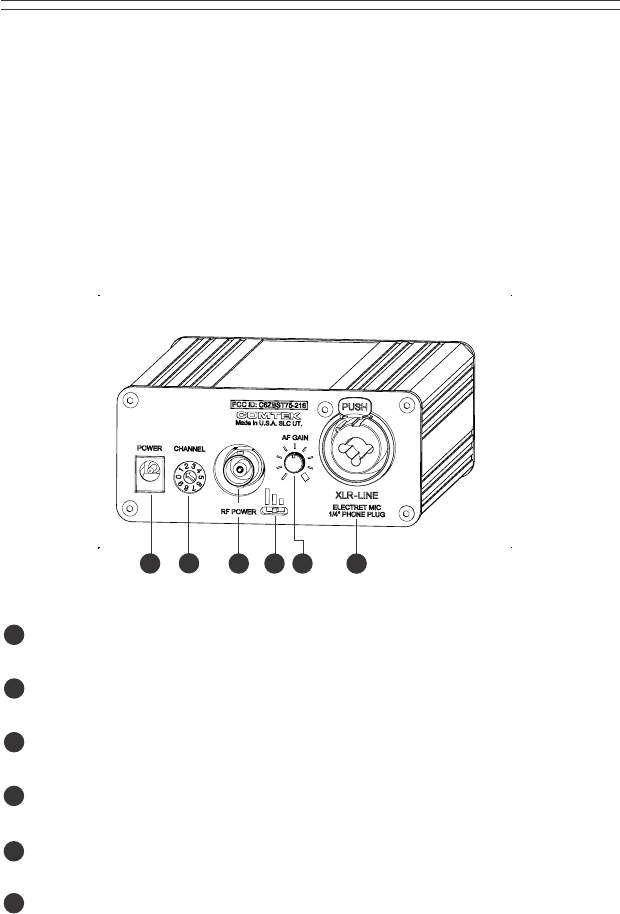
12
7
8
9
10
BST 75-216 REAR PANEL
DC INPUT JACK: Requires 12V DC at 200 mA source.
(Positive or negative center pin.)
CHANNEL SELECTOR SWITCH: Selects the frequency on which the
transmitter will operate. (See Frequency Information Section.)
EXTERNAL ANTENNA JACK: BNC connector provides a standard
50 ohm RF output for use with an external antenna.
RF POWER SWITCH: Adjusts the RF power output of the transmitter
(High-100 mW, Mid-50 mW, Low-25 mW).
AUDIO LEVEL CONTROL: This control is used to set the proper
modulation level when referenced with the VU meter.
MIC / LINE AUDIO INPUT: XLR-3 accepts balanced line level input.
1/4” phone jack accepts AUX input or 2-conductor electret microphone.
11
Page 7
710912811
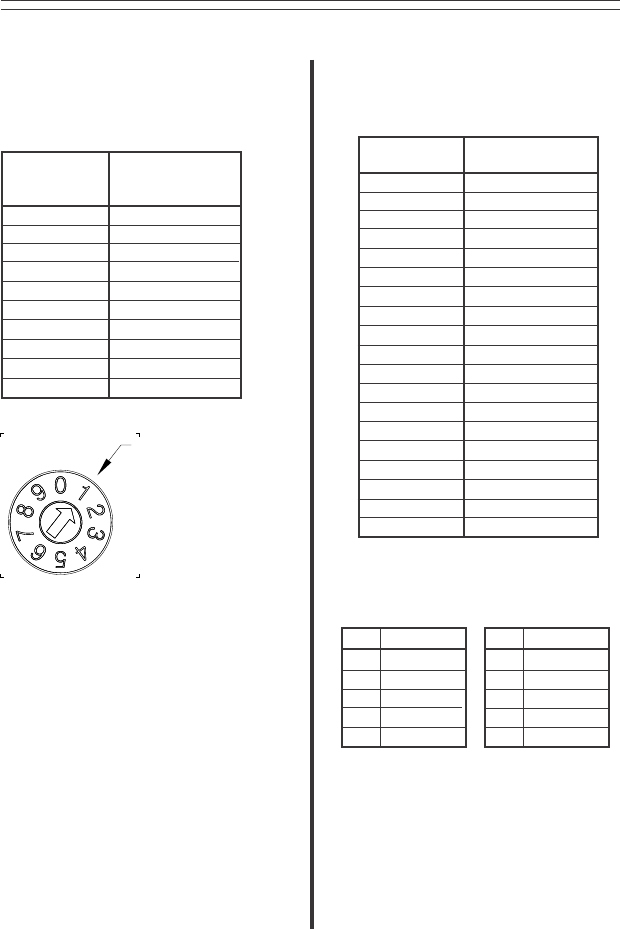
*
Page 8
SWITCH
POSITION CHANNEL
#1
#2
#3
#4
#5
#6
#7
#8
#9
#10
41-216.025
42-216.075
44-216.175
46-216.275
49-216.425
51-216.525
55-216.725
57-216.825
59-216.925
60-216.975
USER-SWITCHABLE
SELECTED CHANNELS
(STANDARD PROGRAM)
AVAILABLE 216 MHz
“FLASH MEMORY”
COMPANDED CHANNELS
BST 75-216 FREQUENCY INFORMATION
GROUP 1
CHAN FREQ
216.025
216.175
216.525
216.725
216.975
41
44
51
55
60
GROUP FREQUENCY CHARTS
CHANNEL FREQUENCY
41
42
43
44
45
46
47
48
49
51
52
53
54
55
56
57
58
59
60
216.0250 MHz
216.0750 MHz
216.1250 MHz
216.1750 MHz
216.2250 MHz
216.2750 MHz
216.3250 MHz
216.3750 MHz
216.4250 MHz
216.5250 MHz
216.5750 MHz
216.6250 MHz
216.6750 MHz
216.7250 MHz
216.7750 MHz
216.8250 MHz
216.8750 MHz
216.9250 MHz
216.9750 MHz
Position #1
Frequency Selection
The BST 75-216 transmitter comes
from the factory on 10 standard
manually selectable channels.
These 10 frequencies have been
selected to create two groups of
five frequencies that have been
coordinated for simultaneous
operation.
GROUP 2
CHAN FREQ
216.075
216.275
216.425
216.825
216.925
42
46
49
57
60
Do not use these channels when
using Group 1 and Group 2
channels together within the
transmitter proximities for
multiple channel operation.
(See page 9, Transmitter Proximites.)
*
*
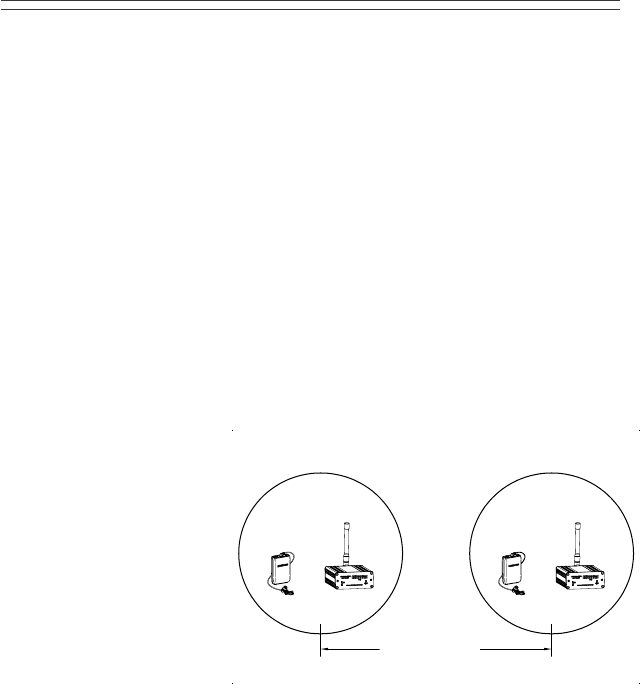
Page 9
Multiple Channel Operation
When multiple transmitters (more than two) are used in the same
proximity, intermodulation interference can occur. This condition
is common to all radio receivers to some extent when multiple
transmitters are used in the same operating area. The RF signals will
“MIX” together generating additional signals. If these product
frequencies are too close to a frequency which the receiver can also
respond to, you will experience intermodulation interference which
may cause undesirable operation.
To avoid this type of interference when multiple transmitters are used
in the same proximity, transmitting frequencies must be coordinated
by selecting from frequencies in the same group.
(See group frequency chart on page 8.)
Transmitter Proximities For
Multiple Channel
Operation
Frequency groups being
transmitted should be
separated by 2X the
operating area; and for
best performance, the
group operating areas
should have a 100 ft.
minimum separation.
Free Frequency Coordination Software
Frequency coordination and after-sale programming for different
compatible frequency groups can be done through COMTEK’s
Technical Support Services. Frequency selection software may be
downloaded from COMTEK’s website at www.comtek/support.html
BST 75-216 FREQUENCY INFORMATION
transmitters
transmitters
Group 1
operating area Group 2
operating area
Transmitter
separation
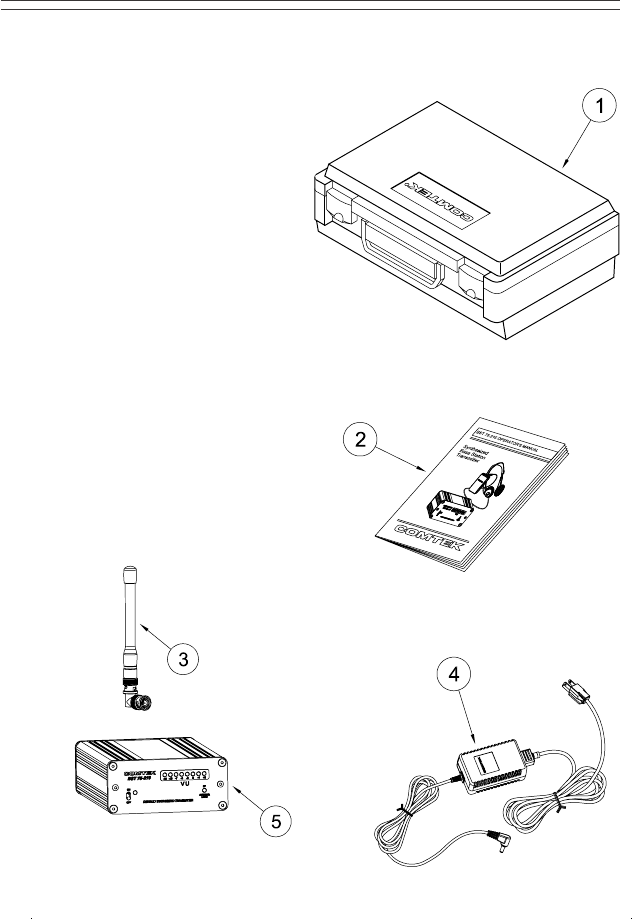
Page 10
BST 75-216 ACCESSORIES
Included Accessories
1. C-75 Carrying case
2. BST-75 Operator’s manual
3. SLW 75-216 Short loaded
whip antenna
4. AP-12VAC Power adaptor
(115V AC Input)
5. BST-75 Base station transmitter
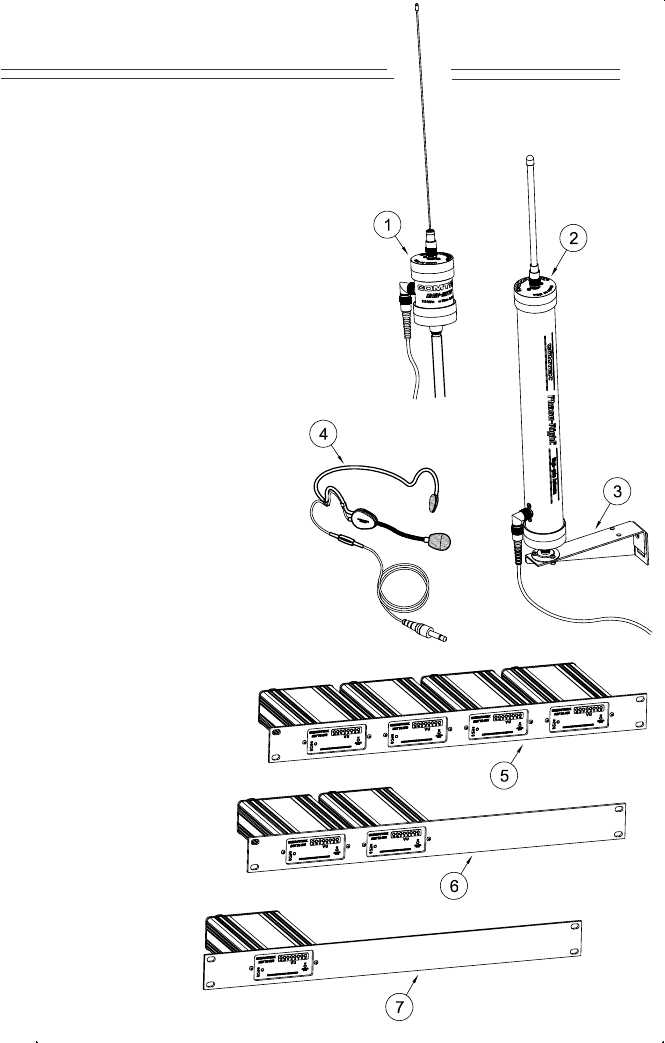
BST 75-216 ACCESSORIES
Page 11
Optional Accessories
1. Mini-Mite 1/2 wave
omni antenna
2. Phase-Right
coaxial antenna
3. PRA Phase-Right
antenna mount
4. HM-100 Behind-the-neck
directional boom microphone
with 1/4” phone jack plug
5. RMK 75-4 Quad
rack-mount face plate
6. RMK 75-2 Double
rack-mount face plate
7. RMK 75 Single
rack-mount face plate

Page 12
Audio Inputs:
Line level balanced input
0 dBm for 80% modulation
(+20 dBm max, XLR-3F)
Unbalanced input with bias
voltage for electret microphone
(-35 dBv at 5 K ohms. 1/4” mono plug)
Connectors:
XLR-3F Combo with 1/4”
phone jack
Barrel type 5.5mm X 2.1mm
power jack DC
BNC type RF output
Operation Indicators:
LED bargraph VU meter
LED antenna load and SWR indicator
LED DC power indicator
Antenna:
Short loaded BNC whip antenna
BNC RF output connector for
optional external antenna
FCC Compliance:
Type Certification and Type
Acceptance under FCC Part 95.
Power Requirements:
12 Volts DC, 200 mA max
Frequency Response:
100 Hz to 10 kHz
Audio Distortion:
Less than 1% at 80% modulation
Audio Gain Control:
Limited to 20 dB
Modulation Limiter:
Peak compressor type with
high linear overload protection
(25 dB). Attack time less than
1 ms, recovery time 10 ms
Audio Processing:
Companded and non-companded
to accommodate a variety of
receivers
RF Output Power:
Maximum power output for
FCC Part 95 (100 mW)
Frequency Stability:
Better than 0.002% digitally
synthesized, crystal controlled
Frequency Modulation:
10 kHz deviation companded
5 kHz deviation non-companded
Operating Frequency:
216.0125 to 216.9750 MHz
(57 channels)
Custom factory programmed
to 10 of 19 available high-fidelity
companded channels or may be
programmed to 10 of 38 standard
non-companded NB channels
Harmonic and Spurious Emissions:
Better than 50 dB below carrier
Dimensions:
3 3/4" X 1 5/8" X 5 1/4" deep
Weight:
17 oz.
BST 75-216 SPECIFICATIONS
•
•
•
•
•
•
•
NOTE: Specifications subject to
change without notice
or obligation
•
•
•
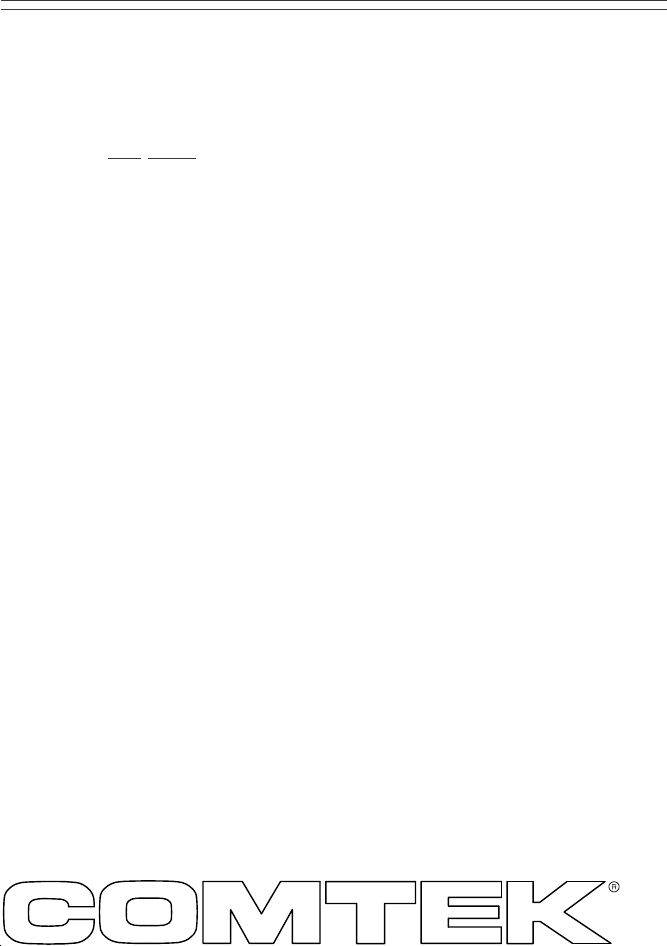
WARRANTY AND SERVICE
Warranty
COMTEK transmitters and receivers are warranted to be free from defects in
workmanship and material under normal stand-alone use and conditions for
a period of two years from date of original purchase. Items such as
headphones and earphones, neckloops, and cords are warranted to be
free from defects in workmanship and material for a period of 90 days from
the date of original purchase. Batteries are not covered by this warranty.
Damage due to abnormal use, extreme conditions, misuse, use of the product
as a component of another product, ill treatment and unauthorized
modification and repairs are not covered by this warranty. COMTEK is not
liable for any consequential or punitive damages arising out of any failure
of the equipment to perform as intended. COMTEK shall bear no
responsibility or obligation with respect to the manner of use of any
equipment sold by it. COMTEK SPECIFICALLY DISCLAIMS AND
NEGATES ANY WARRANTY OF MERCHANTABILITY OR FITNESS
OF THE PRODUCT FOR A PARTICULAR PURPOSE INCLUDING,
WITHOUT LIMITATION, ANY WARRANTY THAT THE USE OF SUCH
EQUIPMENT FOR ANY PURPOSE WILL COMPLY WITH APPLICABLE
LAWS AND REGULATIONS.
Service Policies
Warranty repairs must be done by COMTEK. Only factory technicians are
authorized to perform warranty service on the BST 75-216 transmitter. Before
returning the BST 75-216 for service, a Return Authorization Number should
be obtained from the service department by calling 1-800-496-3463 or
1-801-466-3463. Return the unit to the factory with the original or comparable
packing. COMTEK will pay for insurance and ground return shipping costs in
the United States for all warranty service.
357 West 2700 South • Salt Lake City, Utah 84115 • Phone: (800) 496-3463 • Fax: (801) 484-6906 • www.comtek.com
E-mail: sales@comtek.com

357 West 2700 South • Salt Lake City, Utah 84115 • Phone: (800) 496-3463 • Fax: (801) 484-6906 • www.comtek.com